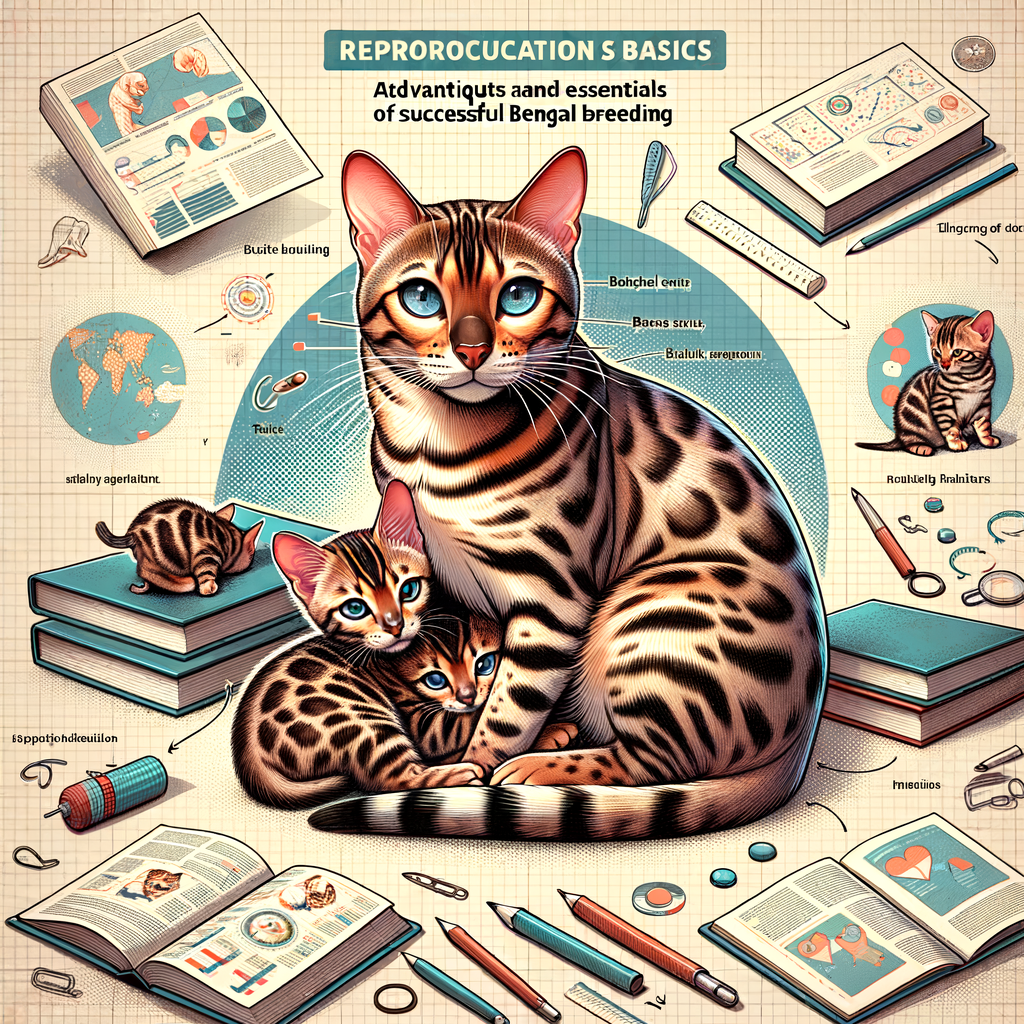
Bengal Cat Breeding Guide: An Overview
Welcome to our comprehensive guide on Bengal cat breeding. This overview will give you a clear understanding of the basics and advanced techniques involved in Bengal cat breeding. Whether you’re a cat enthusiast or a professional breeder, this guide will provide you with valuable insights.
- Understanding Bengal Cat Breeding
- Bengal Cat Reproduction Basics
- Advanced Bengal Cat Breeding Techniques
Bengal cat breeding is a process that requires a deep understanding of the breed’s unique characteristics. Bengals are a hybrid breed, created by crossing an Asian Leopard Cat with a domestic cat. They are known for their striking coat patterns and playful, energetic nature. Breeding these cats requires knowledge about their genetics, health issues, and behavioral traits.
Like other cats, Bengals have a gestation period of approximately 63-67 days. A female Bengal cat, or queen, can have anywhere from 1 to 6 kittens per litter, with an average of 3-4. It’s essential for the queen to be in good health before breeding, as this can significantly impact the kittens’ health. The queen should be at least one year old and have undergone necessary health screenings.
Advanced Bengal cat breeding techniques involve selective breeding to enhance specific traits. This could be to improve the Bengal’s distinctive coat, increase their size, or even to reduce the risk of certain health issues. It’s crucial to remember that ethical breeding practices should always be followed, prioritizing the health and well-being of the cats over any desired physical traits.
In the following sections, we will delve deeper into the essentials of Bengal cat breeding, advanced breeding techniques, and expert advice to help you on your breeding journey. Stay tuned!
Understanding Bengal Cat Breeding: The Essentials
When it comes to Bengal cat breeding, there are three essential areas to understand: genetics and pedigree, health and wellness, and temperament and personality. Let’s delve into each of these areas to gain a deeper understanding.
- Genetics and Pedigree
Bengal cats are a unique breed, and their genetics play a significant role in their breeding. Understanding the pedigree of a Bengal cat can help predict the traits and characteristics of their offspring. For instance, the color and pattern of a Bengal cat’s coat are determined by their genes. Some Bengals have a rosette pattern, while others have a marble pattern, and these traits can be passed down to their kittens.
It’s also important to note that Bengal cats are a hybrid breed. They were initially bred from the Asian Leopard Cat, a wild feline species, and domestic cats. This unique heritage contributes to their distinctive appearance and behavior.
- Health and Wellness
Health and wellness are paramount in Bengal cat breeding. Bengal cats are generally healthy, but they can be prone to certain health issues, such as progressive retinal atrophy (a disease that affects the eyes) and hypertrophic cardiomyopathy (a heart condition). Regular vet check-ups and a balanced diet can help ensure the health and wellness of Bengal cats and their offspring.
Here’s a simple table to illustrate some common health issues in Bengal cats:
| Health Issue | Description |
|---|---|
| Progressive Retinal Atrophy | A disease that affects the eyes, leading to blindness. |
| Hypertrophic Cardiomyopathy | A heart condition that can lead to heart failure. |
- Temperament and Personality
The temperament and personality of Bengal cats are also essential factors in breeding. Bengal cats are known for their high energy levels and playful nature. They are intelligent, curious, and love to explore their surroundings. These traits can be inherited by their kittens.
However, each Bengal cat is unique, and their temperament can vary. Some may be more outgoing, while others may be more reserved. Understanding the temperament and personality of a Bengal cat can help breeders ensure a good match between the parents, resulting in kittens that are well-adjusted and happy.
Advanced Bengal Cat Breeding Techniques
When it comes to Bengal cat breeding, there are several advanced techniques that can help ensure successful outcomes. These techniques require a deep understanding of the breed, careful planning, and meticulous management. Let’s explore some of these key factors in detail.
Breeding Bengal Cats Successfully: Key Factors
There are three main factors that contribute to successful Bengal cat breeding:
- Choosing the Right Pair
- Understanding the Breeding Cycle
- Managing Pregnancy and Birth
Choosing the right pair of Bengal cats for breeding is crucial. It’s important to consider the health, temperament, and genetic history of both cats. A healthy pair with good temperaments and a clear genetic history can increase the chances of producing healthy and well-behaved kittens.
Bengal cats, like other felines, have a specific breeding cycle. Understanding this cycle is key to successful breeding. Female Bengals typically go into heat several times a year and this is the optimal time for breeding. Males, on the other hand, are ready to mate at any time.
Once a Bengal cat becomes pregnant, it’s important to provide her with proper care and nutrition. Regular vet check-ups are essential to monitor the health of the mother and kittens. As the birth approaches, prepare a comfortable and quiet birthing area for the mother. After birth, both the mother and kittens will require ongoing care and monitoring.
By focusing on these key factors, you can increase your chances of breeding Bengal cats successfully. Remember, each cat is unique and may require different care and attention. Always consult with a professional breeder or vet for personalized advice.
Bengal Cat Breeding Tips: Expert Advice
- Tip 1: Regular Health Check-ups
Regular health check-ups are essential for Bengal cats. These check-ups help to detect any health issues early, ensuring your cat remains healthy and fit for breeding. Regular vaccinations, deworming, and dental checks are a must. - Tip 2: Proper Nutrition
Proper nutrition plays a crucial role in Bengal cat breeding. A balanced diet rich in proteins, vitamins, and minerals is necessary for the overall health and reproductive system of your Bengal cat. Always consult with your vet for the best diet plan. - Tip 3: Adequate Socialization
Bengal cats need to be adequately socialized from a young age. This helps them to be comfortable around other cats and humans, which is vital for successful breeding. Playtime, interaction, and positive reinforcement are key to socialization. - Takeaway 1: Importance of Genetic Testing
Genetic testing is important in Bengal cat breeding to prevent the transmission of genetic disorders. It helps breeders to ensure that they are breeding healthy cats, contributing to the overall health of the breed. - Takeaway 2: Role of Proper Care and Nutrition
Proper care and nutrition are not just important for the health of your Bengal cat, but also for successful breeding. A well-cared-for and well-fed cat is more likely to breed successfully and produce healthy kittens. - Takeaway 3: Significance of Adequate Socialization
Adequate socialization plays a significant role in Bengal cat breeding. A well-socialized cat is more likely to breed successfully and raise well-adjusted kittens. - Reflection on the Importance of Understanding Bengal Cat Breeding
Understanding Bengal cat breeding is crucial for anyone considering breeding these beautiful cats. It involves more than just pairing two cats together. It requires a deep understanding of the breed, their health, nutrition, and social needs. - Recap of Advanced Bengal Cat Breeding Techniques
Advanced Bengal cat breeding techniques include genetic testing, selective breeding, and proper care and nutrition. These techniques help to ensure the health and wellbeing of the cats and the success of the breeding program. - Summary of Expert Bengal Cat Breeding Tips
In summary, successful Bengal cat breeding requires regular health check-ups, proper nutrition, and adequate socialization. It also involves understanding the importance of genetic testing and the role of proper care and nutrition. With these expert tips, you can ensure the success of your Bengal cat breeding program.






